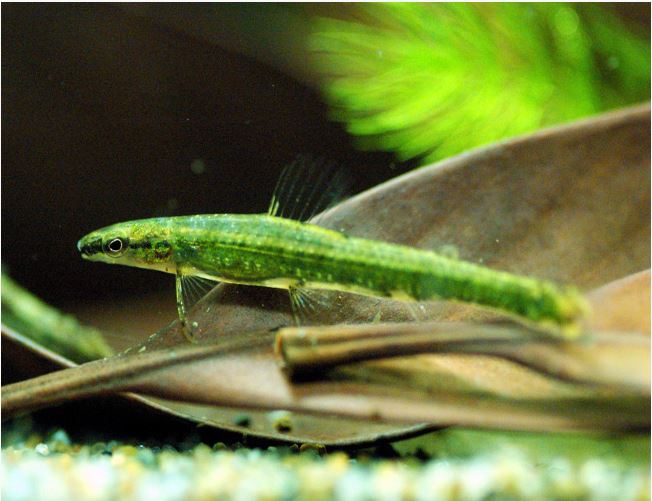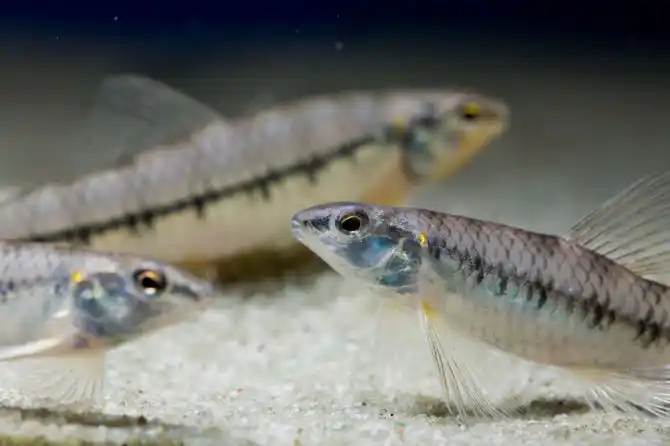Are you looking for a fascinating addition to your aquarium? Look no further than the darter tetra. These small, active fish are known for their vibrant colors and striking appearance.
With their active swimming behavior, they bring a lively energy to any tank. Darter tetras thrive in a well-maintained habitat with plenty of hiding spots and a balanced diet.
Whether you’re an experienced aquarist or just starting out, the darter tetra is sure to captivate and delight.
Quick facts about Darter Tetra
- Darter Tetra is a common name for several species of small, freshwater fish in the family Crenuchidae, including the Black Darter Tetra (Poecilocharax weitzmani) and the Banded Darter Tetra (Characidium fasciatum)16.
- Darter Tetra are native to South America and are found in slow-moving streams and rivers with sandy or rocky substrates14.
- They are small fish that typically grow to around 2 inches (5 cm) in length24.
- Darter Tetra are peaceful and social fish that should be kept in groups of at least six individuals in a tank of at least 20 gallons24.
- They are relatively easy to care for and can be fed a variety of foods, including live, frozen, and flake foods24.
- Darter Tetra prefer soft and slightly acidic water with a pH between 6.0 and 7.514.
- They are compatible with other peaceful fish species such as tetras, rasboras, and dwarf cichlids4.
- Darter Tetra are not as commonly available in pet stores as other tetra species, but they are interesting and unique fish that can make a great addition to a community tank
Habitat and Natural Environment
In their natural habitat, darter tetras prefer slow-moving bodies of water with plenty of vegetation for cover. These tetras thrive in water with a temperature range of 72-82°F and a pH level between 6.5-7.5. They’re highly adaptable and can tolerate slight variations in these parameters, but extreme changes can be detrimental to their health.
Darter tetras are social fish and are often found in groups, interacting with each other and other fish species. They exhibit peaceful behavior and are compatible with a wide range of community fish, including other tetras, rasboras, and small catfish. However, they may become territorial during breeding season.
It’s important to provide ample hiding spots and spaces for darter tetras to establish their territories while maintaining a harmonious environment with their tankmates.

Physical Characteristics and Appearance
You can easily identify the darter tetra by its vibrant colors and sleek, streamlined body shape. This small fish species, commonly found in freshwater habitats, exhibits a fascinating array of color variations.
Some individuals display a brilliant combination of iridescent blues and greens, while others feature vibrant reds and oranges. These striking color patterns serve multiple purposes, including attracting mates and signaling dominance or aggression.
Additionally, the darter tetra possesses distinctive behavioral patterns. It’s known for its energetic swimming style, darting swiftly through the water in search of food or to escape predators. Furthermore, these fish are highly social and often form tight-knit shoals, providing safety in numbers.
Observing the darter tetra’s vibrant colors and unique behaviors can evoke a sense of wonder and appreciation for the diverse beauty of the aquatic world.
Feeding and Diet
When feeding, you’ll notice that the darter tetra has a varied diet, consisting of small insects, crustaceans, and plant matter. These feeding habits are essential for meeting their nutritional needs.
The darter tetra is an omnivorous species, meaning it consumes both animal and plant-based food sources. Small insects, such as mosquito larvae and small crustaceans, like daphnia, make up a significant portion of their diet. Additionally, they also consume plant matter, including algae and aquatic plants.
This diverse diet ensures that the darter tetra obtains the necessary nutrients for growth, reproduction, and overall health. By feeding on a wide range of food sources, the darter tetra is able to adapt to different environments and maintain its nutritional balance in various habitats.
Tank Setup and Water Requirements
Darter Tetras, also known as Olive Tetras or Darting Tetras (scientific name: Poecilocharax weitzmani), are small and active fish native to the blackwater environments in South America. If you’re considering setting up an aquarium for Darter Tetras, it’s crucial to mimic their natural habitat as closely as possible. Here’s a guide on their tank setup and water requirements:
Tank Setup:
- Size: A minimum of 20 gallons (75 liters) is recommended for a small group of Darter Tetras. Given their active nature, they’ll appreciate the space to dart and swim around.
- Substrate: Use a dark, fine-grained substrate to simulate their blackwater habitats. This not only makes them feel more at home but also accentuates their colors.
- Plants: Darter Tetras thrive in heavily planted tanks. Incorporate a mix of floating plants and rooted ones. Plants like Java Fern, Anubias, and Amazon Sword can be used.
- Hiding Spots: Provide plenty of hiding spots using driftwood, rocks, and dense plant thickets. These give the fish a sense of security.
- Lighting: These fish are used to subdued lighting due to the tannin-rich waters of their natural habitat. Consider using dim lights or floating plants to diffuse the lighting.
- Filtration: They don’t require strong currents, so a moderate filtration system that provides clean and well-oxygenated water is ideal.
Water Requirements:
- Temperature: Darter Tetras prefer temperatures between 73°F to 80°F (23°C to 27°C).
- pH Level: They thrive in slightly acidic water, so a pH of 5.5 to 7.0 is ideal.
- Hardness: Soft water is preferred, with a general hardness (GH) of 1 to 8 dGH.
- Water Coloration: In the wild, they’re accustomed to blackwater conditions – water rich in tannins. You can achieve this by adding Indian almond leaves or driftwood, which releases tannins over time. This will give the water a tea-colored tint and also provide beneficial properties for the fish.
- Water Changes: Regular water changes, around 20-25% weekly, will help in maintaining water quality.
- Tannins: While Darter Tetras enjoy tannin-rich environments, it’s important to monitor the pH. The addition of tannins can lower pH, so always test the water after making changes.

Feeding: Darter Tetras are omnivorous and will accept a variety of foods. Offer them a mix of high-quality flake foods, micro pellets, and occasional live or frozen foods like brine shrimp or daphnia.
When setting up a tank for Darter Tetras, always make sure to cycle the tank properly before introducing the fish and monitor the water parameters regularly to ensure their well-being.
Tank Mates for Darter Tetra
Darter Tetras (Poecilocharax weitzmani) are peaceful, small fish that are best suited for community tanks with other similarly sized and non-aggressive species. When considering tank mates for Darter Tetras, it’s essential to ensure compatibility in terms of temperament, water requirements, and environmental needs. Here are some suitable tank mates for Darter Tetras:
- Other Tetras: Species such as Cardinal Tetras, Neon Tetras, Ember Tetras, and Black Neon Tetras can coexist harmoniously with Darter Tetras.
- Rasboras: Harlequin Rasboras, Lambchop Rasboras, and other small rasbora species can make excellent tank mates due to their peaceful nature.
- Dwarf Cichlids: Species like Apistogramma, German Blue Rams, and Bolivian Rams can be a good match, provided they have enough space and territory.
- Corydoras Catfish: These peaceful bottom dwellers, like the Panda Cory or Pygmy Cory, are great companions for Darter Tetras.
- Small Loaches: Kuhli Loaches and Dwarf Chain Loaches can be considered, given their peaceful temperament.
- Livebearers: Smaller livebearers like Endler’s Livebearers and Guppies can be suitable tank mates.
- Dwarf Gouramis: Species like the Honey Gourami or Sparkling Gourami can coexist peacefully with Darter Tetras.
- Shrimps: Peaceful invertebrates like Cherry Shrimps, Amano Shrimps, and Ghost Shrimps can share a tank with Darter Tetras without issues.
- Snails: Nerite Snails, Mystery Snails, and Ramshorn Snails can also be compatible tank mates.
- Hatchetfish: Being peaceful surface dwellers, they can coexist well with mid-level swimming Darter Tetras.
Precautions:
- Avoid larger, predatory fish that might see Darter Tetras as food.
- Species known for fin-nipping should be avoided since Darter Tetras have delicate fins.
- Ensure all tank inhabitants have similar water parameter requirements, especially given the specific blackwater conditions preferred by Darter Tetras.
- Always introduce new fish gradually and monitor for signs of aggression or stress. Being prepared to adjust the tank setup or separate incompatible species is essential.
Remember, while selecting tank mates, it’s essential to consider not just the species but the individual temperament of fish, the overall tank environment, and the specific needs of each inhabitant.
Breeding and Reproduction
Breeding and reproduction can be an exciting and rewarding experience for owners of darter tetras. These small, vibrant fish display fascinating reproductive behaviors that are worth studying.
To successfully breed darter tetras, it’s important to provide them with the right environment and conditions. Begin by setting up a separate breeding tank, equipped with fine-leaved plants, such as java moss, for the tetras to lay their eggs on. The water temperature should be maintained between 75-80°F and the pH level around 6.0-7.0.
Once the tank is ready, introduce a pair of darter tetras and observe their reproductive behaviors. The male will actively court the female, displaying vibrant colors and erecting his dorsal fin. The female will respond by laying her eggs on the plants, while the male fertilizes them.
After spawning, it’s important to remove the adult tetras from the breeding tank to prevent them from consuming the eggs.
With patience and careful observation, you can witness the incredible journey of darter tetra reproduction.
Conclusion
In conclusion, the darter tetra is a fascinating fish species that thrives in its natural habitat and exhibits unique physical characteristics.
With a varied diet and specific tank setup requirements, it’s important to provide the appropriate environment and water conditions for optimal health.
The breeding and reproduction process of the darter tetra is an intriguing aspect to explore further in order to better understand its life cycle and population dynamics.

